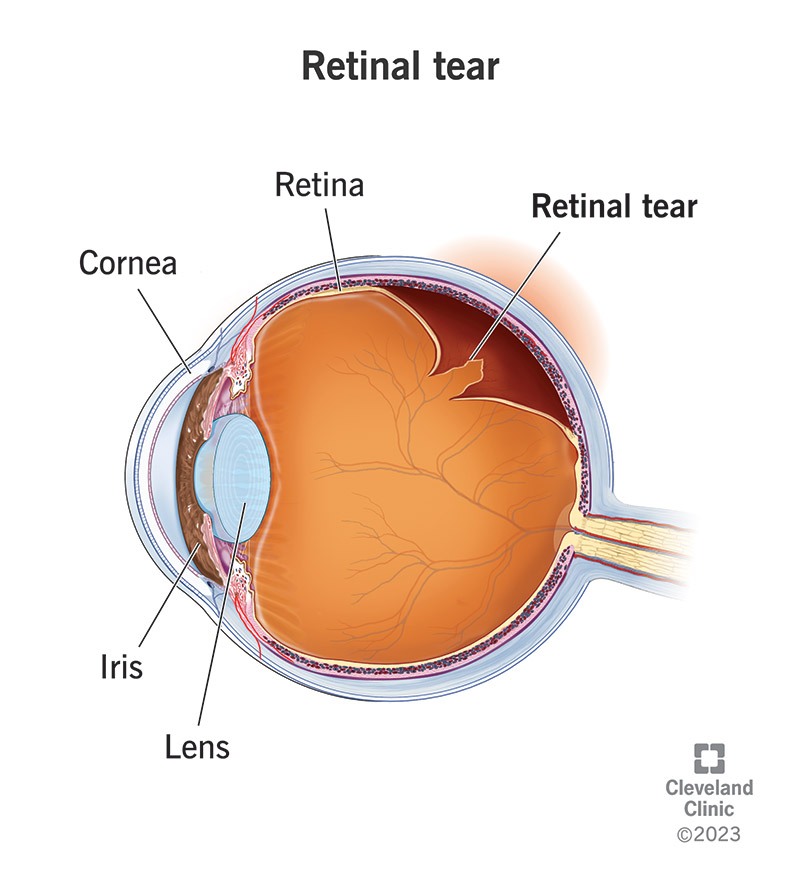A retinal tear is less severe than a retinal detachment, but you still may need treatment. You probably won’t feel pain, but you may have blurry vision and a lot of eye floaters and light flashes. Your provider can repair a tear before it leads to a detached retina.
Advertisement
Cleveland Clinic is a non-profit academic medical center. Advertising on our site helps support our mission. We do not endorse non-Cleveland Clinic products or services. Policy

A retinal tear or break happens when the gel-like vitreous in your eye pulls on your retina and causes a split. Your retina is a thin layer of tissue that’s sensitive to light found at the back of your eye.
Advertisement
Cleveland Clinic is a non-profit academic medical center. Advertising on our site helps support our mission. We do not endorse non-Cleveland Clinic products or services. Policy
A retinal tear isn’t the same as a retinal detachment. A retinal tear could lead to a retinal detachment if the tear isn’t treated. A retinal detachment happens when the retina pulls away from the tissues that support it.
You can also develop a hole in your retina when your retina gets thinner. Retinal holes are less likely to lead to retinal detachment.
Retinal tears and any injury that damages your retina threatens your eyesight and is a medical emergency. Contact your eye care provider as soon as you have retinal tear symptoms or any type of eye injury.
Symptoms of a retinal tear may include:
You might have a retinal tear and have no symptoms.
Retinal tear causes include:
Risk factors for retinal tears include:
Retinal tears can become retinal detachments, which can cause vision loss if they’re not treated.
Your provider needs to be able to see clearly to the back of your eye during the eye exam. They’ll give you drops to widen your eyes (dilate them). Then they’ll use a special lens that’ll let them see your retina at the back of your eye.
Advertisement
If you have a retinal tear, your eye care provider could recommend a retina specialist to do a laser procedure or cryopexy.
With this procedure, your retina specialist will use a laser to repair the retinal tear by surrounding it, preventing it from getting bigger. It also prevents fluid from getting behind the tear. This treatment has another name — photocoagulation. The laser burns your tissue and makes scars that cause the tear to heal.
The repair means that fluid won’t collect behind the break and won’t turn the torn piece into a full-scale retinal detachment.
Photocoagulation takes about 15 minutes.
With cryopexy, your provider will use a freeze treatment to seal the retinal tear. The goal is the same as with a laser procedure — to stop fluid from pushing the retina away from the tissue that supports it. With cryopexy, the extreme cold creates scar tissue and makes the seal.
Cryopexy takes about 30 minutes.
Any type of surgical procedure has potential risks. With a laser procedure or cryopexy, you may have these complications:
You may have to wear an eye patch during a time specified by your provider. You should be able to drive and go back to work, unless your job means that you have to lift heavy things or participate in strenuous activities. It may take weeks for your eye to heal enough to do those things.
If you have treatment, or if your retinal tear heals on its own, your prognosis is good. If the tear is large and untreated, it could get worse and cause a retinal detachment. That condition is a medical emergency.
You really can’t prevent a retinal tear, but you can do things to protect your eyes and sight, including:
If you’ve had treatment for a retinal tear and you have any issues afterward, contact your provider or go to an emergency room. These types of issues include:
Advertisement
It can be scary to hear that you have a tear in your retina, especially when you might not be feeling anything that lets you know you have it. But your eye care provider can help you by repairing the retinal tear. Make the call to your provider. They want to keep your eyes healthy, too.
Advertisement
Your eyes are one of your most important senses. If something goes wrong, it can change your world. Cleveland Clinic can help treat all types of retinal disease.

Last reviewed on 06/18/2023.
Learn more about the Health Library and our editorial process.